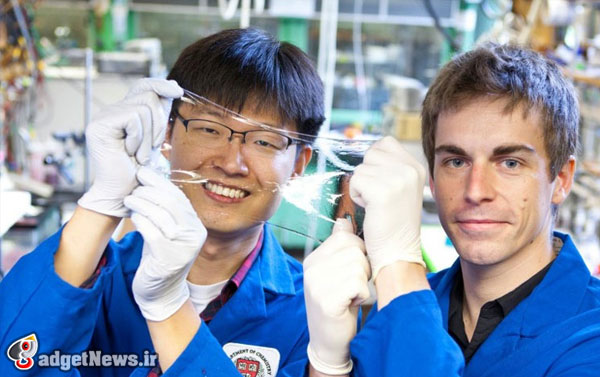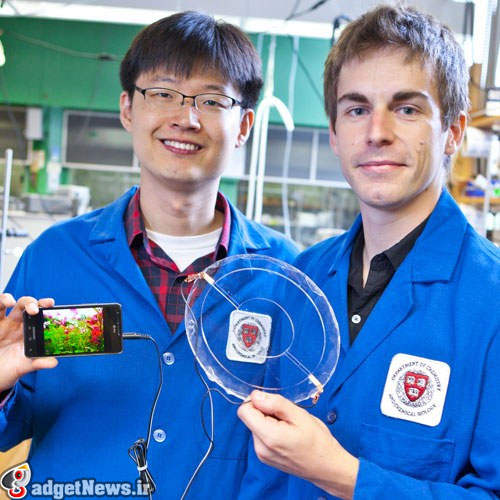
امروزه بلندگوها به اشکال متفاوتی عرضه میشوند، از انواع کوچک و جیبی گرفته تا طراحیهای بزرگ و خیره کننده؛ اما گروهی از پژوهشگران در دانشگاه هاروارد تصمیم گرفتند به جای تغییر ابعاد به تغییر رنگ فکر کنند و بلندگویی بسازند که درست مثل شیشه شفاف و بی رنگ است. این پژوهشگران در دانشکده مهندسی و علوم کاربردی بلندگویی منعطف ساختند که از نوعی ژل یونی و شفاف ساخته شده است و با صدایی واضح تمام فرکانسهای محدودهی شنوایی را پوشش میدهد. علاوه بر این آنها اثبات کردند که میتوان سیگنالهای الکتریکی را به روشی مشابه با سیستم عصبی انسان انتقال داد.
 برای ساخت این بلندگوی شفاف، این گروه دو طرف صفحهای شفاف و لاستیکی را با لایهای از ژلی رسانا از آب و نمک پوشاندند. با اعمال اختلاف پتانسیل الکتریکی در دو سمت لایه ژل، تمام سطح لاستیک شفاف شروع به لرزیدن میکرد. همان طور که خود میدانید هر لرزشی در صورتی که فرکانس و شدت مناسبی داشته باشد میتواند تولید صدا کند؛ بنابراین با تنظیم درست ولتاژ میتوان صدایی در محدوده فرکانس شنوایی انسان یعنی از 20 هرتز تا 20 کیلو هرتز به دست آورد. ضمنا این صفحه را میتوان چند برابر مساحت عادی خود کشید و باز هم عملکرد مناسبی از آن انتظار داشت. این محققان معتقدند که میتوان با بهبود عملکرد این ابزار در تبلتها یا نمایشگرهای رایانه برای ایجاد صدا یا بازخوردهای لمسی بدون نیاز به باندگوهای خارجی استفاده کرد.
برای ساخت این بلندگوی شفاف، این گروه دو طرف صفحهای شفاف و لاستیکی را با لایهای از ژلی رسانا از آب و نمک پوشاندند. با اعمال اختلاف پتانسیل الکتریکی در دو سمت لایه ژل، تمام سطح لاستیک شفاف شروع به لرزیدن میکرد. همان طور که خود میدانید هر لرزشی در صورتی که فرکانس و شدت مناسبی داشته باشد میتواند تولید صدا کند؛ بنابراین با تنظیم درست ولتاژ میتوان صدایی در محدوده فرکانس شنوایی انسان یعنی از 20 هرتز تا 20 کیلو هرتز به دست آورد. ضمنا این صفحه را میتوان چند برابر مساحت عادی خود کشید و باز هم عملکرد مناسبی از آن انتظار داشت. این محققان معتقدند که میتوان با بهبود عملکرد این ابزار در تبلتها یا نمایشگرهای رایانه برای ایجاد صدا یا بازخوردهای لمسی بدون نیاز به باندگوهای خارجی استفاده کرد.
هر چند بلندگوهای شفاف به خودی خود جذاب هستند اما هدف اصلی این پروژه بررسی نحوهی استفاده از یونها به جای الکترونها در دستگاههای الکترونیکی بوده است. در بیشتر موارد یونها تحت اختلاف پتانسیل مدارهای الکترونیکی عملکرد کندی دارند و به دلیل احتمال واکنشهای شیمیایی مخرب در صورت افزایش ولتاژ در ولتاژ اعمالی نیز محدودیت وجود دارد. اما در این سیستم جدید، صفحهی لاستیکی به عنوان نوعی عایق عمل میکند و به دانشمندان امکان میدهد تا ضمن کنترل ولتاژ بهتر سرعت اتصالات را نیز افزایش دهند. علاوه بر این، آنها میتوانند با این سیستم انواع جدیدی از مواد رسانا را تولید کنند. مواد رسانای مرسوم عمدتا با کشیده شدن، دچار افزایش مقاومت الکتریکی میشوند، که بازده آنها را در دستگاههای الکترونیکی کاهش میدهد. ولی رساناهای یونی چنین محدودیتی ندارند و قادرند بدون هیچ تغییری در عملکرد تا چند برابر حد عادی خود کشیده شوند. ضمن اینکه میتوان این رساناها را از موادی شفاف ساخت.
به گفتهی آقای Christoph Keplinger یکی از افراد دخیل در این پروژه:
ما میخواهیم نظر مردم در مورد استفاده از رساناهای یونی را تغییر دهیم، سیستم ما نیاز به توان الکتریکی بالایی ندارند و میتوان آن را در هر چیزی که نیاز به تغییر فرم مادهای شفاف با جریان الکتریکی است به کار برد، مثلا صفحه نمایش لپ تاپ، تلویزیون، گوشیهای هوشمند و حتی پنجرههای هوشمند. شما به راحتی میتوانید یکی از اینها را در پنجره هوشمند جای دهید و از آن به عنوان سیستم حذف نویز صدا (Active Noise Cancellation) استفاده کنید و محیطی آرام و بی سروصدا را در داخل خانه تجربه نمایید.
کریستوفن کپلینگر
در کنار انعطاف پذیری و شفافیت باید توجه کرد که این مواد یونها را به روشی مشابه با سیستمهای زیستی انتقال میدهند، مثال روشن آن اعصاب شماست که پالسهای الکتریکی را به کمک یونها انتقال میدهند. این میتواند دروازهای باشد به سمت یکی کردن سیستمهای زیستی با سیستمهای یونی ساخت بشر که میتوان از آنها در پوست مصنوعی یا عضلات مصنوعی استفاده کرد. افقی که در آینده این محصولات وجود دارد ساخت ماشینهایی منطعف است که میتوانند حس کنند و شکل خود را تغییر دهند. برنامهی بعدی این گروه کار کردن بر روی سایر مواد و افزودنیها برای بهبود رسانایی و عملکرد این گونه مواد است. این گروه تحقیقاتی اخیرا طی مقالهای در مجلهی Science نحوهی عملکرد این بلندگوی شفاف را توضیح داده اند.
منبع : gizmag
Researchers build an audio speaker out of stretchy transparent gel
Audio speakers are showing up in a variety of unusual forms these days, from the incredibly tiny to the eye-catchingly bizarre, but a research group at Harvard University may have trumped them all with a speaker that's as clear as glass. Scientists at the college's School of Engineering and Applied Sciences have built a flexible speaker out of ionic gel that is almost invisible to the naked eye and can produce high-quality sound ranging across the full audible spectrum. In doing so, they also provided a proof of concept for electronics that can transfer electric signals in a similar manner to the human nervous system.
To construct the see-through speaker, the group took a transparent rubber sheet and added a layer of conductive saltwater gel to each side. Once a voltage is applied to opposite edges of the gel layers, the entire area of the rubber flexes rapidly, producing sounds ranging from 20 Hz to 20 kHz. Because of the flexibility and ionic properties of the materials, the speaker can be stretched to several times its normal area and still function properly. The scientists believe a more refined version of their invention could be fitted over a computer or tablet screen to provide sound and haptic feedback without the need for external speakers.
A transparent speaker may be impressive on its own, but the real point of the project was to demonstrate how an electric charge passing through ions instead of electrons could be used in electronic devices. In most cases, ionic substances tend to produce slow circuit connections when a voltage is applied to them, and too high a voltage can trigger a chemical reaction that destroys the material entirely. With this new system, however, the rubber acts as an insulator, which allows scientists to better control the voltage and speed up the connection in the process.
According to the research team, if ionic conductors were perfected, they could potentially offer quite a few advantages over conductors typically used today. A common issue with most current flexible conductors is that their resistance increases the more they are stretched, which severely limits their performance in some electronic devices. Ionic conductors on the other hand don't have this problem and can be pulled to several times their regular area without affecting the circuit. An ionic conductor won't be able to match a regular electronic one in terms of resistivity any time soon, but if the goal is to build a circuit that can be warped, then they could be a feasible alternative. As a bonus, ionic conductors can be made from entirely transparent materials.
"We’d like to change people’s attitudes about where ionics can be used," says Christoph Keplinger, a co-author on the project and postdoctoral fellow at Harvard SEAS. "Our system doesn’t need a lot of power, and you can integrate it anywhere you would need a soft, transparent layer that deforms in response to electrical stimuli—for example, on the screen of a TV, laptop, or smartphone to generate sound or provide localized haptic feedback—and people are even thinking about smart windows. You could potentially place this speaker on a window and achieve active noise cancellation, with complete silence inside."
Connecting with our own biology
Aside from being clear and stretchable without hindering the circuit, the gels in the transparent speaker carry ions in much the same way as some biological systems, such as nerves in the human body. This could possibly open the door for merging biological systems with man-made ionic ones, such as artificial muscles or skin.
In the long term, the researchers see their discovery as potentially leading to more advanced "soft machines" that can alter their form on command.
"The big vision is soft machines," says Keplinger, "Engineered ionic systems can achieve a lot of functions that our body has: they can sense, they can conduct a signal, and they can actuate movement. We’re really approaching the type of soft machine that biology has to offer."
Some examples of possible projects they've described include reading glasses that can change their own focal length and robots that reshape themselves to suit different tasks. For the time being, the team plans to continue its research by performing similar experiments with other ionic substances to find which ones can function under a charge longer and which materials can be combined for greater conductivity.
The research group recently explained its ionic speaker project in a paper published in the Aug. 30, 2013 issue of Science.
Professor of Mechanics and Materials at SEAS, Zhigang Suo, put together the research group behind the transparent speaker along with George M. Whitesides, a professor in Harvard's Department of Chemistry and Chemical Biology.
Check out the video below to hear just how crisp the audio from the researchers' ionic speaker sounds.
 گجت نیوز آخرین اخبار تکنولوژی، علم و خودرو
گجت نیوز آخرین اخبار تکنولوژی، علم و خودرو 





